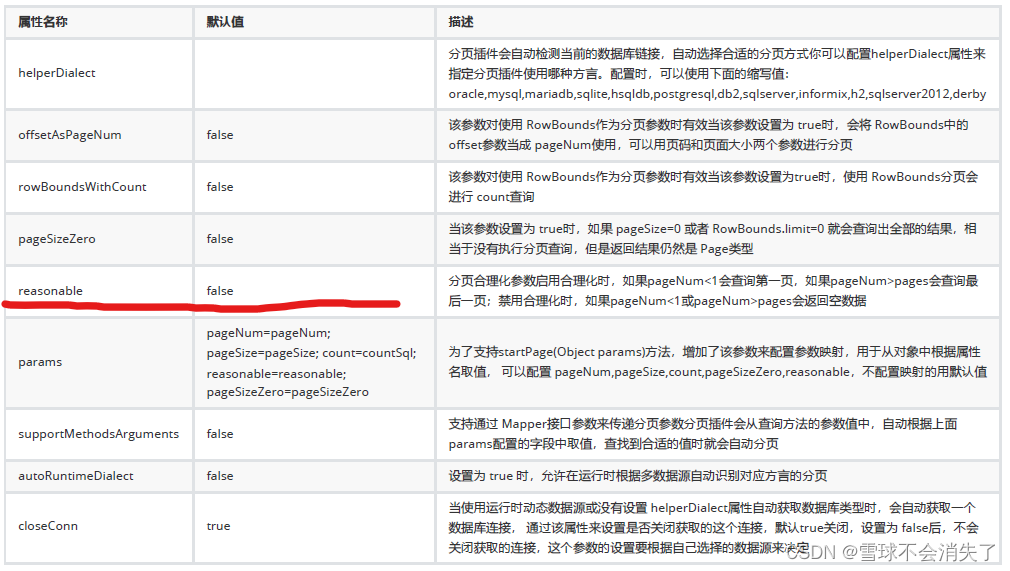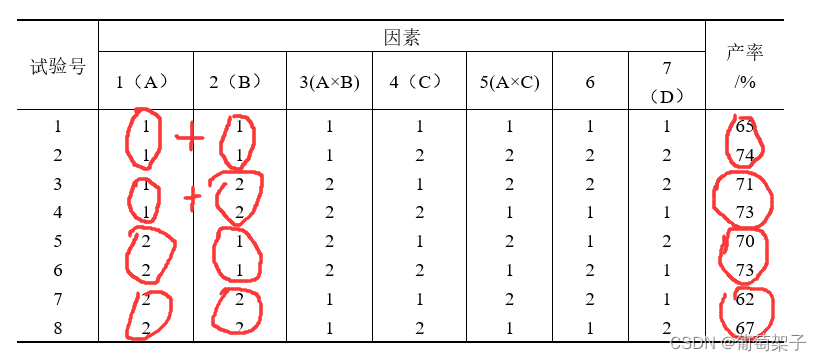目录
数据收集
导入
定义超参数
加载数据
可视化数据
准备数据生成器
定义增强变换
创建训练和验证分割
数据生成器调查
模型构建
模型编译和训练
进行预测并将其可视化
更进一步
政安晨的个人主页:政安晨
欢迎 👍点赞✍评论⭐收藏
收录专栏: TensorFlow与Keras机器学习实战
希望政安晨的博客能够对您有所裨益,如有不足之处,欢迎在评论区提出指正!
本文目标:利用数据增强和迁移学习训练关键点检测器。
关键点检测包括对物体关键部位的定位。例如,人脸的关键部位包括鼻尖、眉毛、眼角等。这些部分有助于以特征丰富的方式表示底层对象。关键点检测的应用包括姿势估计、人脸检测等。
在本例中,我们将使用斯坦福 Extra 数据集,利用迁移学习建立一个关键点检测器。
本示例需要 TensorFlow 2.4 或更高版本,以及 imgaug 库,可使用以下命令安装:
!pip install -q -U imgaug数据收集
StanfordExtra 数据集包含 12,000 张狗的图像以及关键点和分割图。该数据集由斯坦福狗数据集发展而来。
可通过以下命令下载:
!wget -q http://vision.stanford.edu/aditya86/ImageNetDogs/images.tar注释在 StanfordExtra 数据集中以单个 JSON 文件的形式提供,用户需要填写此表格才能访问该文件。
作者明确指示用户不要共享 JSON 文件,本示例也尊重这一愿望:您应自行获取 JSON 文件。
JSON 文件的本地版本为 stanfordextra_v12.zip。
下载文件后,我们可以解压缩。
!tar xf images.tar
!unzip -qq ~/stanfordextra_v12.zip导入
from keras import layers
import kerasfrom imgaug.augmentables.kps import KeypointsOnImage
from imgaug.augmentables.kps import Keypoint
import imgaug.augmenters as iaafrom PIL import Image
from sklearn.model_selection import train_test_split
from matplotlib import pyplot as plt
import pandas as pd
import numpy as np
import json
import os定义超参数
IMG_SIZE = 224
BATCH_SIZE = 64
EPOCHS = 5
NUM_KEYPOINTS = 24 * 2 # 24 pairs each having x and y coordinates加载数据
作者还提供了一个元数据文件,其中指定了有关关键点的其他信息,如颜色信息、动物姿势名称等。我们将在 pandas 数据框中加载该文件,以提取信息用于可视化目的。
IMG_DIR = "Images"
JSON = "StanfordExtra_V12/StanfordExtra_v12.json"
KEYPOINT_DEF = ("https://github.com/benjiebob/StanfordExtra/raw/master/keypoint_definitions.csv"
)# Load the ground-truth annotations.
with open(JSON) as infile:json_data = json.load(infile)# Set up a dictionary, mapping all the ground-truth information
# with respect to the path of the image.
json_dict = {i["img_path"]: i for i in json_data}json_dict 的单个条目如下所示:
'n02085782-Japanese_spaniel/n02085782_2886.jpg':
{'img_bbox': [205, 20, 116, 201],'img_height': 272,'img_path': 'n02085782-Japanese_spaniel/n02085782_2886.jpg','img_width': 350,'is_multiple_dogs': False,'joints': [[108.66666666666667, 252.0, 1],[147.66666666666666, 229.0, 1],[163.5, 208.5, 1],[0, 0, 0],[0, 0, 0],[0, 0, 0],[54.0, 244.0, 1],[77.33333333333333, 225.33333333333334, 1],[79.0, 196.5, 1],[0, 0, 0],[0, 0, 0],[0, 0, 0],[0, 0, 0],[0, 0, 0],[150.66666666666666, 86.66666666666667, 1],[88.66666666666667, 73.0, 1],[116.0, 106.33333333333333, 1],[109.0, 123.33333333333333, 1],[0, 0, 0],[0, 0, 0],[0, 0, 0],[0, 0, 0],[0, 0, 0],[0, 0, 0]],'seg': ...}
在这个例子中,我们感兴趣的键是:
img_path
joints
关节中总共有 24 个条目。
每个条目有 3 个值:
x 坐标
y 坐标
关键点的可见性标志(1 表示可见,0 表示不可见)
我们可以看到,关节点包含多个 [0, 0, 0] 条目,表示这些关键点没有被标记。
在本例中,我们将同时考虑非可见和未标记的关键点,以便进行迷你批量学习。
# Load the metdata definition file and preview it.
keypoint_def = pd.read_csv(KEYPOINT_DEF)
keypoint_def.head()# Extract the colours and labels.
colours = keypoint_def["Hex colour"].values.tolist()
colours = ["#" + colour for colour in colours]
labels = keypoint_def["Name"].values.tolist()# Utility for reading an image and for getting its annotations.
def get_dog(name):data = json_dict[name]img_data = plt.imread(os.path.join(IMG_DIR, data["img_path"]))# If the image is RGBA convert it to RGB.if img_data.shape[-1] == 4:img_data = img_data.astype(np.uint8)img_data = Image.fromarray(img_data)img_data = np.array(img_data.convert("RGB"))data["img_data"] = img_datareturn data可视化数据
现在,我们编写一个实用程序来可视化图像及其关键点。
# Parts of this code come from here:
# https://github.com/benjiebob/StanfordExtra/blob/master/demo.ipynb
def visualize_keypoints(images, keypoints):fig, axes = plt.subplots(nrows=len(images), ncols=2, figsize=(16, 12))[ax.axis("off") for ax in np.ravel(axes)]for (ax_orig, ax_all), image, current_keypoint in zip(axes, images, keypoints):ax_orig.imshow(image)ax_all.imshow(image)# If the keypoints were formed by `imgaug` then the coordinates need# to be iterated differently.if isinstance(current_keypoint, KeypointsOnImage):for idx, kp in enumerate(current_keypoint.keypoints):ax_all.scatter([kp.x],[kp.y],c=colours[idx],marker="x",s=50,linewidths=5,)else:current_keypoint = np.array(current_keypoint)# Since the last entry is the visibility flag, we discard it.current_keypoint = current_keypoint[:, :2]for idx, (x, y) in enumerate(current_keypoint):ax_all.scatter([x], [y], c=colours[idx], marker="x", s=50, linewidths=5)plt.tight_layout(pad=2.0)plt.show()# Select four samples randomly for visualization.
samples = list(json_dict.keys())
num_samples = 4
selected_samples = np.random.choice(samples, num_samples, replace=False)images, keypoints = [], []for sample in selected_samples:data = get_dog(sample)image = data["img_data"]keypoint = data["joints"]images.append(image)keypoints.append(keypoint)visualize_keypoints(images, keypoints)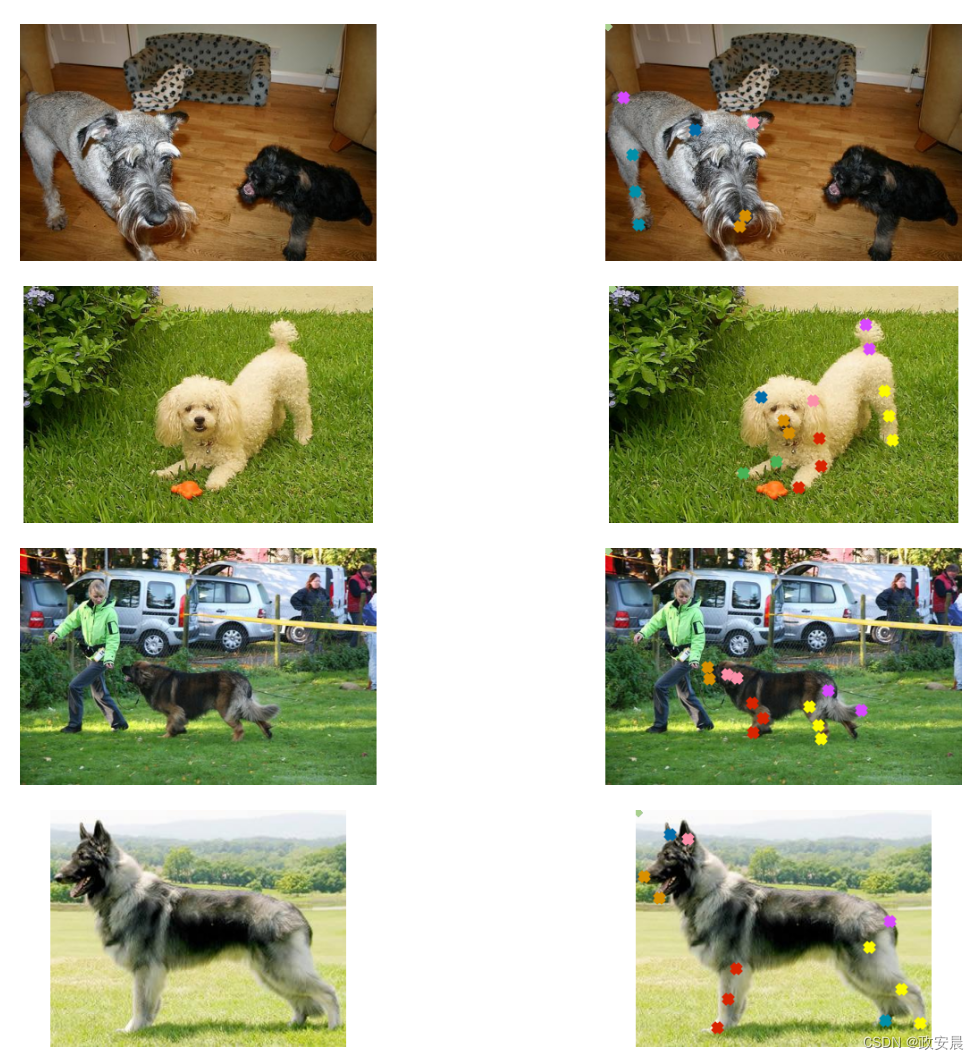
从图中可以看出,我们的图像大小并不均匀,这在现实世界的大多数情况下都是意料之中的。
但是,如果我们将这些图像的大小调整为统一形状(例如 (224 x 224)),它们的地面实况注释也会受到影响。
如果我们对图像进行任何几何变换(例如水平翻转),情况也是一样。幸运的是,imgaug 提供了可以处理这个问题的实用程序。
在后文中,我们将编写一个继承 keras.utils.Sequence 类的数据生成器,使用 imgaug 对成批数据进行数据增强。
准备数据生成器
class KeyPointsDataset(keras.utils.PyDataset):def __init__(self, image_keys, aug, batch_size=BATCH_SIZE, train=True, **kwargs):super().__init__(**kwargs)self.image_keys = image_keysself.aug = augself.batch_size = batch_sizeself.train = trainself.on_epoch_end()def __len__(self):return len(self.image_keys) // self.batch_sizedef on_epoch_end(self):self.indexes = np.arange(len(self.image_keys))if self.train:np.random.shuffle(self.indexes)def __getitem__(self, index):indexes = self.indexes[index * self.batch_size : (index + 1) * self.batch_size]image_keys_temp = [self.image_keys[k] for k in indexes](images, keypoints) = self.__data_generation(image_keys_temp)return (images, keypoints)def __data_generation(self, image_keys_temp):batch_images = np.empty((self.batch_size, IMG_SIZE, IMG_SIZE, 3), dtype="int")batch_keypoints = np.empty((self.batch_size, 1, 1, NUM_KEYPOINTS), dtype="float32")for i, key in enumerate(image_keys_temp):data = get_dog(key)current_keypoint = np.array(data["joints"])[:, :2]kps = []# To apply our data augmentation pipeline, we first need to# form Keypoint objects with the original coordinates.for j in range(0, len(current_keypoint)):kps.append(Keypoint(x=current_keypoint[j][0], y=current_keypoint[j][1]))# We then project the original image and its keypoint coordinates.current_image = data["img_data"]kps_obj = KeypointsOnImage(kps, shape=current_image.shape)# Apply the augmentation pipeline.(new_image, new_kps_obj) = self.aug(image=current_image, keypoints=kps_obj)batch_images[i,] = new_image# Parse the coordinates from the new keypoint object.kp_temp = []for keypoint in new_kps_obj:kp_temp.append(np.nan_to_num(keypoint.x))kp_temp.append(np.nan_to_num(keypoint.y))# More on why this reshaping later.batch_keypoints[i,] = np.array(kp_temp).reshape(1, 1, 24 * 2)# Scale the coordinates to [0, 1] range.batch_keypoints = batch_keypoints / IMG_SIZEreturn (batch_images, batch_keypoints)要进一步了解如何在 imgaug 中使用关键点,请查看本文。
定义增强变换
train_aug = iaa.Sequential([iaa.Resize(IMG_SIZE, interpolation="linear"),iaa.Fliplr(0.3),# `Sometimes()` applies a function randomly to the inputs with# a given probability (0.3, in this case).iaa.Sometimes(0.3, iaa.Affine(rotate=10, scale=(0.5, 0.7))),]
)test_aug = iaa.Sequential([iaa.Resize(IMG_SIZE, interpolation="linear")])创建训练和验证分割
np.random.shuffle(samples)
train_keys, validation_keys = (samples[int(len(samples) * 0.15) :],samples[: int(len(samples) * 0.15)],
)数据生成器调查
train_dataset = KeyPointsDataset(train_keys, train_aug, workers=2, use_multiprocessing=True
)
validation_dataset = KeyPointsDataset(validation_keys, test_aug, train=False, workers=2, use_multiprocessing=True
)print(f"Total batches in training set: {len(train_dataset)}")
print(f"Total batches in validation set: {len(validation_dataset)}")sample_images, sample_keypoints = next(iter(train_dataset))
assert sample_keypoints.max() == 1.0
assert sample_keypoints.min() == 0.0sample_keypoints = sample_keypoints[:4].reshape(-1, 24, 2) * IMG_SIZE
visualize_keypoints(sample_images[:4], sample_keypoints)演绎展示:
Total batches in training set: 166
Total batches in validation set: 29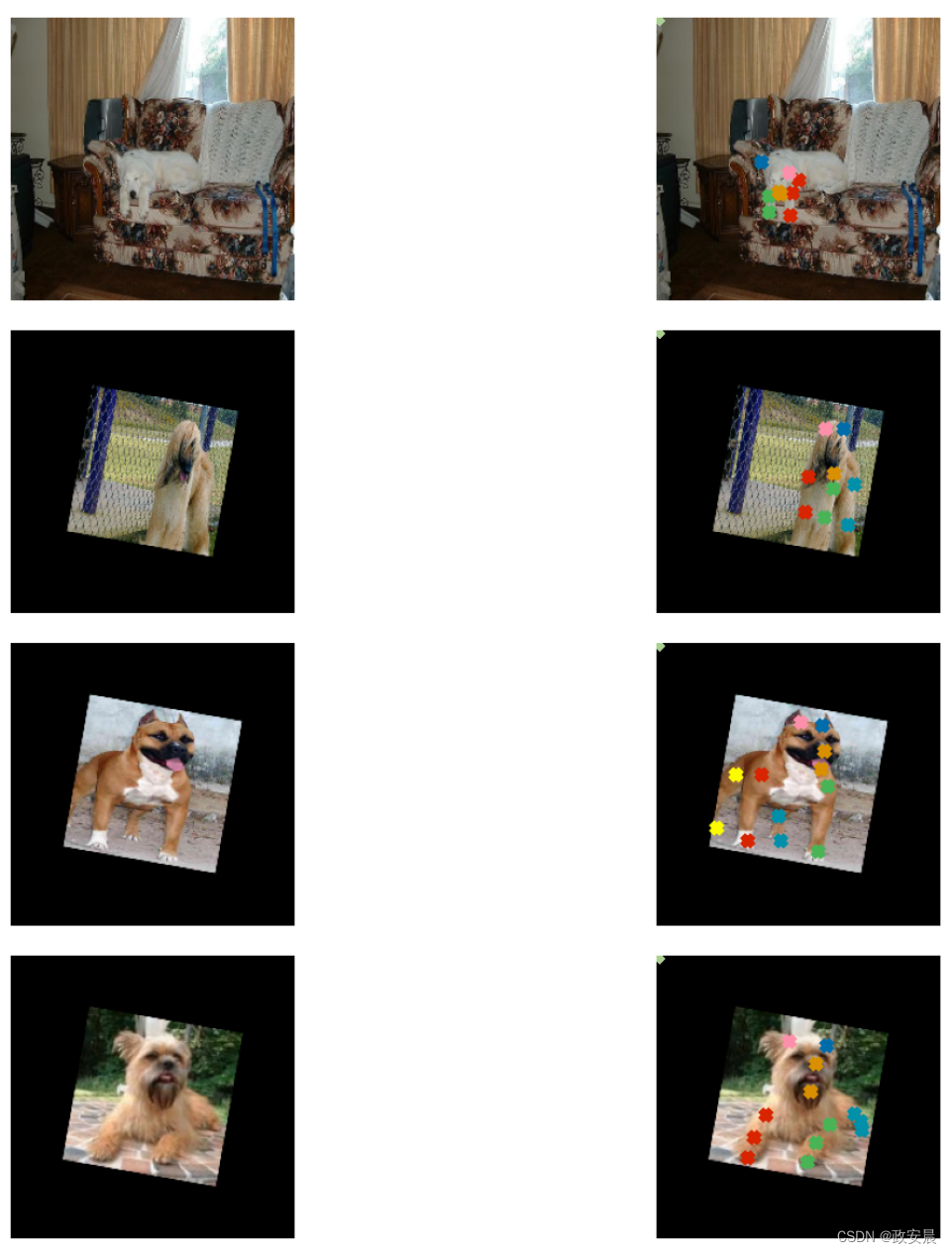
模型构建
Stanford dogs 数据集(StanfordExtra 数据集基于该数据集)是使用 ImageNet-1k 数据集构建的。因此,在 ImageNet-1k 数据集上预训练的模型很可能对这项任务有用。我们将使用在该数据集上预先训练好的 MobileNetV2 作为骨干,从图像中提取有意义的特征,然后将这些特征传递给自定义回归头用于预测坐标。
def get_model():# Load the pre-trained weights of MobileNetV2 and freeze the weightsbackbone = keras.applications.MobileNetV2(weights="imagenet",include_top=False,input_shape=(IMG_SIZE, IMG_SIZE, 3),)backbone.trainable = Falseinputs = layers.Input((IMG_SIZE, IMG_SIZE, 3))x = keras.applications.mobilenet_v2.preprocess_input(inputs)x = backbone(x)x = layers.Dropout(0.3)(x)x = layers.SeparableConv2D(NUM_KEYPOINTS, kernel_size=5, strides=1, activation="relu")(x)outputs = layers.SeparableConv2D(NUM_KEYPOINTS, kernel_size=3, strides=1, activation="sigmoid")(x)return keras.Model(inputs, outputs, name="keypoint_detector")我们定制的网络是全卷积网络,因此与具有全连接密集层的相同版本网络相比,它对参数更加友好。
get_model().summary()演绎展示:
Downloading data from https://storage.googleapis.com/tensorflow/keras-applications/mobilenet_v2/mobilenet_v2_weights_tf_dim_ordering_tf_kernels_1.0_224_no_top.h59406464/9406464 ━━━━━━━━━━━━━━━━━━━━ 0s 0us/step
请注意网络的输出形状:(None, 1, 1, 48)。
这就是我们重塑坐标的原因:batch_keypoints[i, :] = np.array(kp_temp).reshape(1, 1, 24 * 2)。
模型编译和训练
在本例中,我们只对网络进行 5 个历元的训练。
model = get_model()
model.compile(loss="mse", optimizer=keras.optimizers.Adam(1e-4))
model.fit(train_dataset, validation_data=validation_dataset, epochs=EPOCHS)Epoch 1/5166/166 ━━━━━━━━━━━━━━━━━━━━ 84s 415ms/step - loss: 0.1110 - val_loss: 0.0959
Epoch 2/5166/166 ━━━━━━━━━━━━━━━━━━━━ 79s 472ms/step - loss: 0.0874 - val_loss: 0.0802
Epoch 3/5166/166 ━━━━━━━━━━━━━━━━━━━━ 78s 463ms/step - loss: 0.0789 - val_loss: 0.0765
Epoch 4/5166/166 ━━━━━━━━━━━━━━━━━━━━ 78s 467ms/step - loss: 0.0769 - val_loss: 0.0731
Epoch 5/5166/166 ━━━━━━━━━━━━━━━━━━━━ 77s 464ms/step - loss: 0.0753 - val_loss: 0.0712<keras.src.callbacks.history.History at 0x7fb5c4299ae0>进行预测并将其可视化
sample_val_images, sample_val_keypoints = next(iter(validation_dataset))
sample_val_images = sample_val_images[:4]
sample_val_keypoints = sample_val_keypoints[:4].reshape(-1, 24, 2) * IMG_SIZE
predictions = model.predict(sample_val_images).reshape(-1, 24, 2) * IMG_SIZE# Ground-truth
visualize_keypoints(sample_val_images, sample_val_keypoints)# Predictions
visualize_keypoints(sample_val_images, predictions)演绎展示:
1/1 ━━━━━━━━━━━━━━━━━━━━ 7s 7s/step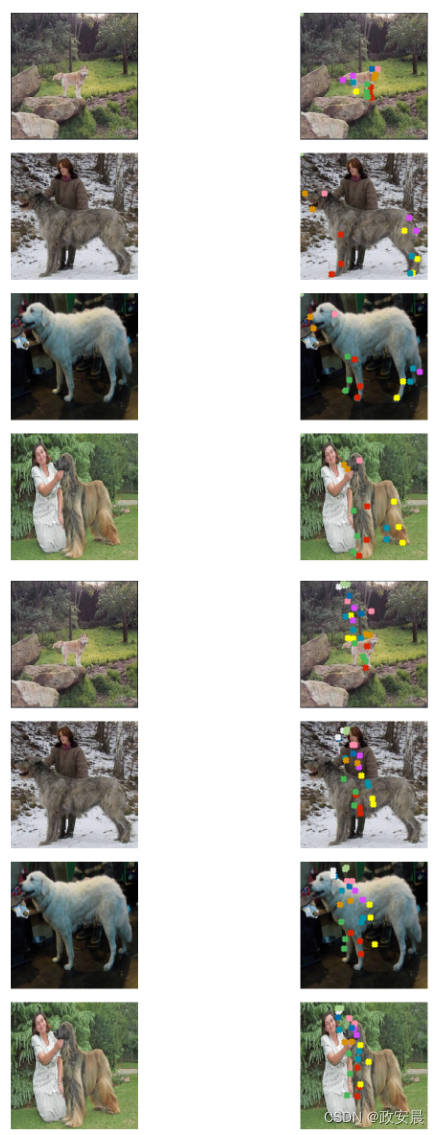
通过更多的训练,预测结果可能会有所改善。
更进一步
尝试使用 imgaug 的其他增强变换,研究其对结果的影响。
在这里,我们从预训练网络中线性转移了特征,也就是说,我们没有对其进行微调。
我们鼓励你在这项任务中对其进行微调,看看是否能提高性能。您还可以尝试不同的架构,看看它们对最终性能有什么影响。



